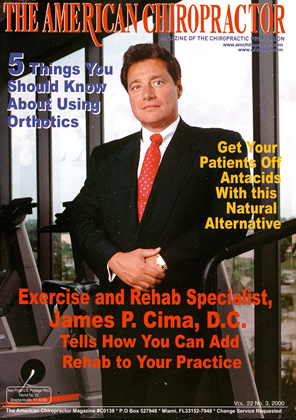Re: Volume 22, Issue 2 Dear TAC: As a 1958 Palmer graduate, I have received literally hundreds of issues of various chiropractic publications. However, I cannot recall enjoying so many items of personal interest in a single issue, as was the case in your Vol. 22, #2 issue. Regarding Dr. Bill Butson's comments in his letter, I must respectfully disagree on a couple points. First, not all chiropractors learned to rely on insurance. Many of us have cash practices. I am a non-participating Medicare provider. My Medicare patients (20% of my practice) pay me and sign a form which explains that I will submit the necessary forms to Medicare, and, if Medicare approves the claim, the patient will be directly reimbursed by Medicare for a portion of the fee with a maximum of twelve visits per year. Most of my Medicare patients do, indeed, receive a check from Medicare. I agree that some form of national health care is coming, but I disagree that things are going to get worse for chiropractors. The only ones I fear will be left behind are the "Chiropractic Physicians", for they have hitched their wagon to a fading star. The Golden Age of Medicine is over, as any experienced medical physician will tell you. It should be obvious to all that the wave of the future is preventive medicine, which chiropractors have been preaching for 100 years. Regarding the article by Dr. Loomis, I was delighted to see his emphasis on the work of Hans Selye. I first read Dr. Selye's text on stress many years ago, and it answered one of the primary philosophical questions which had bothered me. That question was why a wide variety of chiropractic techniques and other therapeutic approaches, such as pharma-ceuticals, nutrition, acupuncture, psychiatry and others, all achieved a respectable percentage of favorable results. Dr. Selye's work answered my question: All forms of stress (mechanical, chemical and emotional) are cumulative. When the cumulative stress reaches the "spillover" point (Dr. Selye's "stage of exhaustion"), disease processes will begin. Therefore, any reduction in any form of stress affecting the body may lower the cumulative stress to a level beneath the spillover point, and healing may begin. The sign on my waiting room wall reads, "Chiropractors are trained to locate and reduce structural stress. The less stress there is on your body, the better your body works, and the better you feel." Thanks again for an excellent issue of The American Chiropractor. James W. Visconti, D.C. Latrobe, PA Editor's Reply: Thank you, James, and the rest of you readers, for telling us what you like as well as what you don't like. Keep the comments coming!
 View Full Issue
View Full Issue






